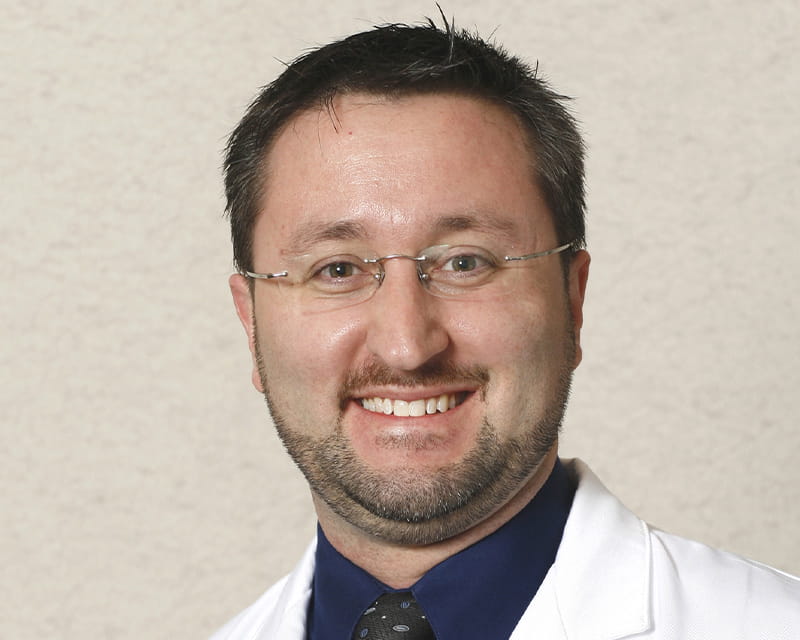
Robotic-assisted surgery with intraoperative radiation offers new hope to patients with local cancer recurrence
 Researchers at The Ohio State University Wexner Medical Center are studying less aggressive management options for prostate cancer, leveraging novel technologies, translational research and canine models.
Researchers at The Ohio State University Wexner Medical Center are studying less aggressive management options for prostate cancer, leveraging novel technologies, translational research and canine models.
“We increasingly recognize that many men with prostate cancer don’t need radical treatment, so physicians are pursuing less aggressive management strategies,” says Shawn Dason, MD, a urologic oncologist at Ohio State. “Right now, we have a lot of data suggesting many patients with early stage localized prostate cancer likely don’t benefit from current whole-gland treatments. In addition, they invariably experience significant sexual and urinary side effects.”
Ohio State is also developing a research and clinical program in localized prostate cancer therapies. The team is collaborating with Tom Rosol, DVM, PhD, MBA, a professor and chair of the Department of Biomedical Sciences at Ohio University, on a preclinical model in which they target cancer cells in the prostate and deliver therapy directly to those areas, minimizing potential damage to healthy prostate cells.
“Dr. Rosol has a canine model that has been optimized for targeting prostate cancer very precisely,” Dr. Dason says. “Our goal is to translate this into an early phase clinical trial for more focal prostate cancer treatment in humans. This is an active collaboration we just started, and it’s going to be something that grows over the next few years.”
The new therapy is intended to address some challenges they see in other treatment methods, like high-intensity focused ultrasound or cryotherapy, where they don’t have the opportunity to address prostate cancer that may be on both sides of the gland.
“With this new therapy, we hope to deliver a treatment to the entire prostate gland that would impact only the tumor, while ideally leaving the noncancerous tissue unaffected,” Dr. Dason says. “We hope this will result in better efficacy for certain tumors that are bilateral or multifocal, while preserving more function than whole-gland or radical therapies like surgery or radiation.”
While this new approach is still being developed, current organ preservation options for prostate cancer, including active surveillance and focal therapy, are being increasingly utilized.
“We’re working to refine our active surveillance protocol and to understand the role of imaging and biomarker technology in stratifying patients for active surveillance,” Dr. Dason says.
Active surveillance involves a physician closely monitoring a patient’s slow-growing prostate cancer. If the disease begins to progress, the physician may determine the patient needs further treatment.
The Ohio State team is also researching best practices in more diverse populations.
“Our diverse patient population is not reflected in the other research that’s been done in more homogenous populations,” he explains. “We’re working to understand how health disparities exist in active surveillance and to optimize protocols based on some of those disparities.”
Dr. Dason, a clinical assistant professor at the College of Medicine, says he and his colleagues are developing a clinical and research program for prostate cancer focal therapy. This treatment approach ablates a limited area of the prostate gland rather than treating the whole gland, with the intention of reducing side effects.
“The Ohio State University Comprehensive Cancer Center–James Cancer Hospital and Solove Research Institute has recently approved high-intensity focused ultrasound for the treatment of prostate cancer, and we’re set up for other alternative technologies, like cryotherapy, as well,” he says. “These new treatment options will allow us to treat only a portion of the prostate gland rather than the entire gland for select patients who are candidates.
“We’re combining this with advances in PET scanning, MRI and MRI-directed biopsy, and novel ultrasound techniques to better understand patient selection for focal therapy and follow-up.”
Because Ohio State is an academic institution, he says the new treatment methods will be subjected to rigorous study, so the team can understand patient outcomes and participate in multi-institutional research on focal therapies.
Dr. Dason says less invasive therapies have the potential to reduce the morbidity of prostate cancer treatment for patients who don’t need radical therapy.
“We increasingly recognize the morbidity of prostate cancer treatment,” he says. “Focal therapy and other conservative management approaches are growing at a rapid rate. Our mission is to ensure that these therapies are subjected to rigorous standards before being employed into practice and that they are only offered to appropriate candidates.”